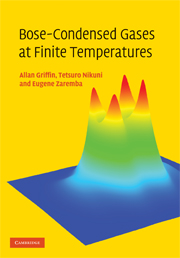Book contents
- Frontmatter
- Contents
- Preface
- 1 Overview and introduction
- 2 Condensate dynamics at T = 0
- 3 Coupled equations for the condensate and thermal cloud
- 4 Green's functions and self-energy approximations
- 5 The Beliaev and the time-dependent HFB approximations
- 6 Kadanoff–Baym derivation of the ZNG equations
- 7 Kinetic equation for Bogoliubov thermal excitations
- 8 Static thermal cloud approximation
- 9 Vortices and vortex lattices at finite temperatures
- 10 Dynamics at finite temperatures using the moment method
- 11 Numerical simulation of the ZNG equations
- 12 Simulation of collective modes at finite temperature
- 13 Landau damping in trapped Bose-condensed gases
- 14 Landau's theory of superfluidity
- 15 Two-fluid hydrodynamics in a dilute Bose gas
- 16 Variational formulation of the Landau two-fluid equations
- 17 The Landau–Khalatnikov two-fluid equations
- 18 Transport coefficients and relaxation times
- 19 General theory of damping of hydrodynamic modes
- Appendix A Monte Carlo calculation of collision rates
- Appendix B Evaluation of transport coefficients: technical details
- Appendix C Frequency-dependent transport coefficients
- Appendix D Derivation of hydrodynamic damping formula
- References
- Index
16 - Variational formulation of the Landau two-fluid equations
Published online by Cambridge University Press: 06 October 2009
- Frontmatter
- Contents
- Preface
- 1 Overview and introduction
- 2 Condensate dynamics at T = 0
- 3 Coupled equations for the condensate and thermal cloud
- 4 Green's functions and self-energy approximations
- 5 The Beliaev and the time-dependent HFB approximations
- 6 Kadanoff–Baym derivation of the ZNG equations
- 7 Kinetic equation for Bogoliubov thermal excitations
- 8 Static thermal cloud approximation
- 9 Vortices and vortex lattices at finite temperatures
- 10 Dynamics at finite temperatures using the moment method
- 11 Numerical simulation of the ZNG equations
- 12 Simulation of collective modes at finite temperature
- 13 Landau damping in trapped Bose-condensed gases
- 14 Landau's theory of superfluidity
- 15 Two-fluid hydrodynamics in a dilute Bose gas
- 16 Variational formulation of the Landau two-fluid equations
- 17 The Landau–Khalatnikov two-fluid equations
- 18 Transport coefficients and relaxation times
- 19 General theory of damping of hydrodynamic modes
- Appendix A Monte Carlo calculation of collision rates
- Appendix B Evaluation of transport coefficients: technical details
- Appendix C Frequency-dependent transport coefficients
- Appendix D Derivation of hydrodynamic damping formula
- References
- Index
Summary
In the collisional region at finite temperatures, the collective modes of superfluids are described by the Landau two-fluid hydrodynamic equations reviewed in Chapter 14. In the case of trapped Bose gases, these are coupled differential equations with position-dependent coefficients associated with the local thermodynamic functions. Building on the approach initiated by Zaremba et al. (1999) for trapped atomic Bose gases, in this chapter we develop an alternative variational formulation of two-fluid hydrodynamics. This is based on the work of Zilsel (1950), originally developed to deal with superfluid He. Assuming a simple variational ansatz for the superfluid and normal fluid velocity fields, this approach reduces the problem of finding the hydrodynamic collective mode frequencies to solving coupled algebraic equations for a few variational parameters. These equations contain constants that involve spatial integrals over various equilibrium thermodynamic derivatives. Such a variational approach is both simpler and more physical than a direct attempt to solve the Landau two-fluid equations numerically.
This chapter is mainly based on Taylor and Griffin (2005), Taylor (2008) and Zilsel (1950). In it, we discuss the normal modes of the non-dissipative Landau two-fluid equations for a trapped superfluid. In Section 16.3, we illustrate this formalism by deriving expressions for the frequencies of the dipole and breathing modes of a trapped Bose superfluid. In Chapters 17 and 18, we discuss an extended version of the two-fluid equations that includes hydrodynamic damping. The hydrodynamic damping of the collective modes is calculated in Chapter 19 using a generalized version of the variational approach developed in this chapter.
Zilsel's variational formulation
Since two-fluid hydrodynamics only describes a system in local equilibrium, all thermodynamic quantities are functions of position and time. Even in static equilibrium, in the presence of a trapping potential, most thermodynamic quantities will be position dependent.
- Type
- Chapter
- Information
- Bose-Condensed Gases at Finite Temperatures , pp. 349 - 370Publisher: Cambridge University PressPrint publication year: 2009



